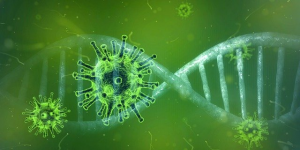In cases of severe Covid-19 disease, patients have significantly lower concentrations of selenium and selenoprotein P and significantly higher levels of oxidative stress. That is to say, there is a more intense formation of harmful free radicals in patients with severe Covid-19 disease [Skesters 2022].

Note: Oxidative stress is the bio-medical term for an imbalance between harmful free radical activity and protective antioxidant activity. Selenium is a key component of antioxidant selenoproteins such as the glutathione peroxidases and the thioredoxin reductases.
Role of Selenium and Selenoprotein P in Covid-19 Disease
Researchers have been investigating the role that selenium may play in reducing the severity and mortality of Covid-19 infections. Studies have shown a close relationship between low selenium status, Selenoprotein P deficiency, oxidative stress level, and Covid-19 disease incidence, severity, and prognosis [Skesters 2022].
- Selenium deficiency is associated with a weakened immune response to viruses and with the increased virulence of some viruses, including the coronaviruses.
- Viral infections are associated with increased production of reactive oxygen species (free radicals).
- Oxidative stress can be considered a key characteristic of viral infections.
- The production the free radicals knows as reactive oxygen species can enhance the replication of viruses.
Selenium Deficiency and Reduced Immune Function and Higher Incidence of Covid-19
- Selenium is incorporated into 25 known selenoproteins with various biological functions in the body.
- Sufficient intake of selenium is important for immune system functions and for antioxidant defense functions.
- Selenoprotein P is one of the most important selenoproteins. It is the primary transporter of selenium in the blood circulation.
Study of the Levels of Selenium, Selenoprotein P, and Oxidative Stress in Coivd-19 Patients
Skesters et al investigated the blood plasma levels of selenium and selenoprotein P and malondialdehyde (a biomarker for oxidative stress) in 40 acutely ill Covid-19 patients and in 80 post-Covid-19 disease patients.
Plasma selenium levels
- The study data showed that the selenium content in the blood of the post-Covid-19 infection patients was similar to the lower blood selenium levels of healthy Latvian citizens, i.e., in the range of 84.6 mcg/L and 88.2 mcg/L.
- The selenium content of the acutely ill Covid-19 patients, on the other hand, was significantly decreased compared with post-Covid-19 infection patients: 69.7 mcg/L.
- In acutely ill Covid-19 patients treated in the intensive care unit (rather than on regular hospital wards), the plasma selenium levels was as low as 59.3 mcg/L.
Note: There is some evidence to indicate that plasma/serum selenium levels below 70 mcg/L are indicative of selenium deficiency, plasma/serum selenium levels below 100 mcg/L are sub-optimal levels, and plasma/serum levels around 125 mcg/L are optimal for good health [Al-Mubarak 2021; Rayman 2020].
Plasma selenoprotein P levels
- The study data showed that the contents of selenoprotein P in plasma were 4.5 mg/mL for the acute patients and in the range of 5.5 mg/mL to 6.8 mg/mL in the post-COVID-19 patients.
- Research has shown that selenoprotein P plays a crucial role in neuroprotection during periods of high oxidative stress [Skesters 2022].
Plasma malondialdehyde levels
- The study data showed extremely high levels of malondialdehyde – a biomarker for oxidative stress – in both groups of patients, acutely ill Covid-19 patients and post-Covid-19 patients.
- In all Covid-19 patient groups, the plasma levels of malondialdehyde were many times higher than the levels in healthy individuals.
Discussion of the Selenium and Covid-19 Study Results
Skesters and the research team characterized the study results as follows:
- Plasma concentrations of selenium and selenoprotein P in the acutely ill Covid-19 patients were low and extremely low, respectively.
- Plasma selenium concentrations in the acutely ill Covid-19 patients in the intensive care unit were catastrophically low.

Skesters and his colleagues concluded that it is very important to detect this selenium and selenoprotein deficiency in Covid-19 patients, especially so in in patients in intensive care. Selenium and selenoprotein P deficiencies are related to an overall antioxidant deficiency in immune system processes in the body [Skesters 2022].
In a separate study, Chen et al showed that low soil content of the trace element zinc is also associated with increased risk of death from Covid-19 infection [Chen 2022].
Conclusion: Selenium and Covid-19 Infections
Skesters et al have concluded that there is a need for organic selenium preparations and natural antioxidants that can be used as an adjunctive therapy for preventive purposes and during illness and recovery [Skesters 2022].
In this context, it is worth noting that Richie et al have shown that supplementation with a selenium-enriched yeast product significantly reduced biomarker levels of oxidative stress in healthy men whereas supplementation with pure selenomethionine did not. Their findings suggest that there are selenium-containing compounds in selenium-enriched yeast products other than selenomethionine that may account for the decrease in oxidative stress [Richie 2014].
Sources
Al-Mubarak AA, van der Meer P, Bomer N. Selenium, selenoproteins, and heart failure: current knowledge and future perspective. Curr Heart Fail Rep. 2021;18(3):122-131.
Chen Y, Ma ZF, Yu D. Geographical distribution of trace elements (selenium, zinc, iron, copper) and case fatality rate of COVID-19: a national analysis across conterminous USA. Environ Geochem Health (2022). https://doi.org/10.1007/s10653-022-01204-0.
Rayman MP. Selenium intake, status, and health: a complex relationship. Hormones (Athens). 2020 Mar;19(1):9-14.
Richie JP Jr, Das A, Calcagnotto AM, et al. Comparative effects of two different forms of selenium on oxidative stress biomarkers in healthy men: a randomized clinical trial. Cancer Prev Res (Phila). 2014;7(8):796-804.
Skesters A, Kustovs D, Lece A, Moreino E, Petrosina E, Rainsford KD. Selenium, selenoprotein P, and oxidative stress levels in SARS-CoV-2 patients during illness and recovery. Inflammopharmacology. 2022 Feb 14:1–5.
The information presented in this review article is not intended as medical advice and should not be used as such.
15 May 2022
